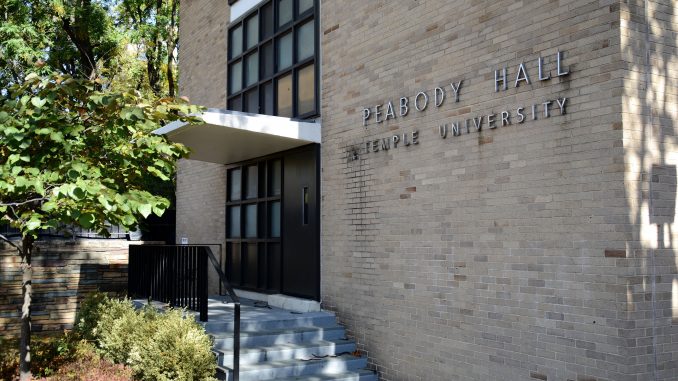
Peabody Residence Hall will be demolished “from the top-down” beginning during winter break, officials said.
The building will be demolished over the next three months, and a new building will later be rebuilt on the land facing Broad and Norris streets.
When students return to campus after winter break, Peabody will “most likely be down in the ground with a lump of dirt,” said Jerry Leva, the vice president of planning and capital projects.
“By the time students come back, the most critical parts and dangerous parts for pedestrians will be down and we’ll just be just cleaning up,” Leva added.
Two or three machines will claw at the the building, removing concrete beams from each floor before it’s entirely demolished.
Temple is working with the city’s Streets Departments to decide whether street closures will be necessary during demolition. Leva said it’s possible that officials will shut down Norris Street, but it will only be temporary and last a day at most.
Peabody Residence Hall, the university’s oldest residence hall, housed its last class of first-year students in the 2016-2017 academic year. The building had 287 beds and accommodated students for more than 60 years.
Students like Alec Strosser, a sophomore art education major, was one of the last students to live in Peabody.
“Walking by it, it’s crazy to not see anybody walking in and out and not see people in the window because that was all I’d see last year,” Strosser said. “Now it’s just an empty tomb that’s waiting to be [demolished].”
Strosser said he will miss the community created in those halls. The building’s small size allowed a unique college experience for Strosser to make friends and meet other people, he added.

SASHA LASAKOW / THE TEMPLE NEWS
“I wish [Temple] would keep Peabody because it has so much character and you can’t just replace that,” Strosser said. “Last year we would always wish and wish that they don’t tear it down soon. Now this is the year that it’s happening. It’s pretty mind boggling to seeing it be prepped.”
Peabody was built in 1957 as part of Temple’s transition from a commuter campus to a traditional university.
The cost of demolition is still being finalized, but it is cheaper than the “nominal” cost of keeping it standing, Leva added.
Originally, the university planned to demolish Peabody during fall break, but winter break was determined to be “the best time” to do so, Leva said.
The university is evaluating how to use the space after demolition and hopes to complete this evaluation by Summer 2018 to begin construction again.
“We’re looking at raising a building and optimizing the location of the building on Broad and Norris, and we want to optimize that so we’re looking at the best height to maximize the best use for Temple,” Leva said.
Although the new building’s purpose has not been determined, the university is considering a multi-use building, with spaces like classrooms, housing or administrative offices.
“[Peabody’s demolition is] a great thing, it’s a great location,” he added. “I know it will be something great that students will love.”



Be the first to comment